If possible, swim at a beach with a lifeguard. Surf beach lifeguards rescue greater than 50,000 people a year from rip current.
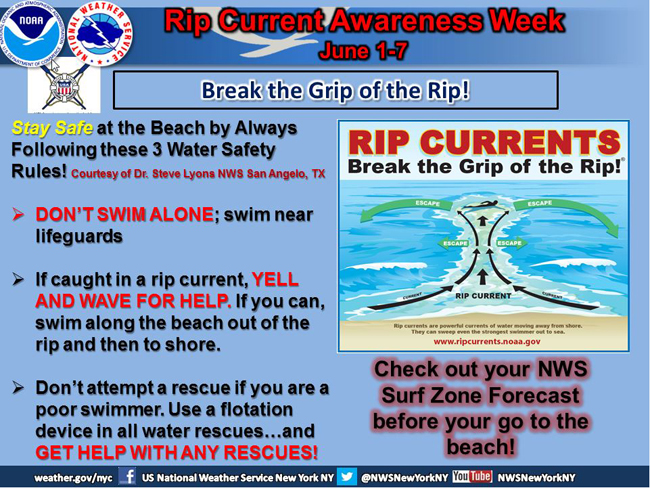
NOAA, Sea Grant and their partners know you're looking forward to a summer of fun in the sun at the shore, but we want you to be aware of the dangers of rip currents. If you're knowledgeable of these dangers, you can make sure you enjoy a safe summer at the shore. Photo: NOAA's U.S. National Weather Service - New York NY
New York, NY, June 1, 2014 - Today marks the beginning of the National Oceanic and Atmospheric Administration's seasonal campaign on rip current awareness. NOAA partners with its coastal science-focused National Sea Grant Program as well as the United States Lifesaving Association (USLA) and the National Park Service (NPS) to raise the overall profile of beach safety nationwide.
The key thing to remember is "Know before you go and you will be safe from head to toe." Two beach hazards are deemed most dangerous: rip currents and breaking waves in the surf zone. Information on these and many other beach/surf zone related hazards are detailed on each of the partner Web sites, which are, respectively, www.ripcurrents.noaa.gov, www.nws.noaa.gov/beachhazards and www.usla.org. Also, we at New York Sea Grant archive all our related content at www.nyseagrant.org/ripcurrents.
So, what are rip currents? They are channelized currents of water flowing away from shore at surf beaches. Typically they form at breaks in sandbars, and also near structures, such as jetties and piers and cliffs that jut out into the water.
Rip currents are common and can be found on most surf beaches, including the Great Lakes and Gulf of Mexico.
So, what should you do if you're caught up in a rip current?
NOAA, Sea Grant and their partners urge you to:
- Stay calm.
- Don't fight the current. It's a natural treadmill.
- Relax and float conserving your energy. This can be lifesaving.
- Escape the current by swimming in a direction following the shoreline. When free from the pull of the current, swim at an angle away from the current toward shore.
- If at any time you feel you will be unable to reach shore, draw attention to yourself: face the shore, call or wave for help.
- An easy jingle to remember is: Wave and yell…and swim parallel.
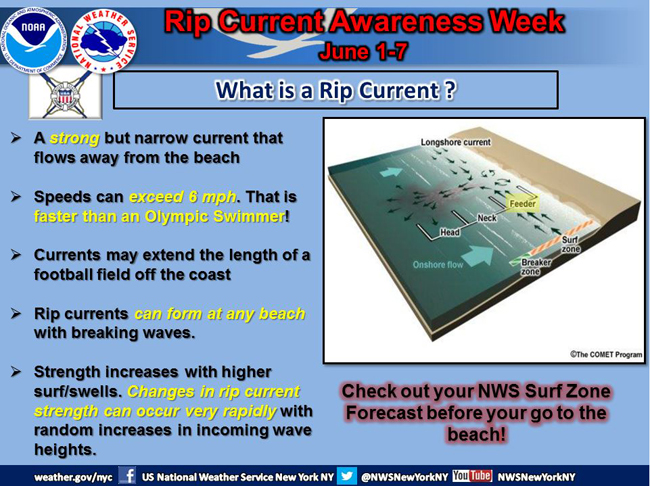
Did you know that the speed of a rip current can be faster than that of an Olympic swimmer? You don't want to mess with that! Photo: NOAA's U.S. National Weather Service - New York NY
Some other helpful beach tips include:
- Know how to swim before you venture in!
Changing ocean currents and winds are difficult enough for those who do know how to swim, and can be quite fatiguing. So, you should be a strong swimmer before going into the water.
According to the USLA, learning how to swim is the best defense against drowning. Learn how to swim. Some swimming programs now teach individuals how to escape rip currents. Annually, America's surf beach lifeguards rescue more than 50,000 swimmers from rip currents. Always swim at a lifeguard protected beach.
- Know what the surf zone forecasts are from the National Weather Service
These can be found at: www.nws.noaa.gov/beachhazards/surfzones.shtml. Click on the dot closest to the beach you are visiting. You can also ask the hotel or rental agency you are using for local sources of weather and beach forecasts.
- Take your cell phone to the beach
In case of an emergency, where the lifeguard is not present, call 911. If you go to the beach three people, one can be in the ocean swimming, one on the beach watching, and one available to take lifesaving actions.
- Before entering water, ask yourself, is the water safe?
Beach warning flags are often posted on or near a lifeguard's stand. Typically, a green flag means water conditions are safe, but other colors usually mean conditions are not safe. They are meant to protect your life and others, please read and obey the posted beach signs, warning flags, and lifeguards.
- Know where the safety stations are on the beach
Here you will find floatation devices, such as life rings. If a swimmer is caught in a rip current, a floatation device can be thrown out to them keeping them afloat until they are rescued. Other actions you can take are, throwing an ice chest that floats to the swimmer caught in the current, or throw a line to them to pull them in.
- Swim with one or more buddies
According to the USLA, many drownings involve single swimmers. When you swim with a buddy, if one of you has a problem, the other may be able to help, including signaling for assistance from others. At least have someone onshore watching you.
- Always watch your children carefully
This goes especially for children playing near the edge of the ocean or in it. A sudden wave or current could quickly drag them through the surf out to the breaking waves. Remember, a child can drown in seconds.
- Watch out for waves
Large waves and strong currents in the surf zone can knock adults off their feet and can even pull a good swimmer out to sea. If the current makes you feel unsteady on your feet or if waves are breaking over your waist, it's time to either move to calmer or shallower water, or get out of the water completely. An easy jingle to remember about ocean waves is "Stay Dry When the Waves are High."
- How to head into the water
According to the USLA, enter the water feet first. Diving into breaking waves is dangerous. You don't know how deep the water is, there might be a sandbar just beneath. Breaking waves, large or small, can flip you and drive your head into the wet sand which is like concrete causing severe neck and spinal injuries.
- Never turn your back on the ocean
Ocean waves can hit you suddenly causing severe neck and spinal cord injuries. Even small waves can be dangerous.
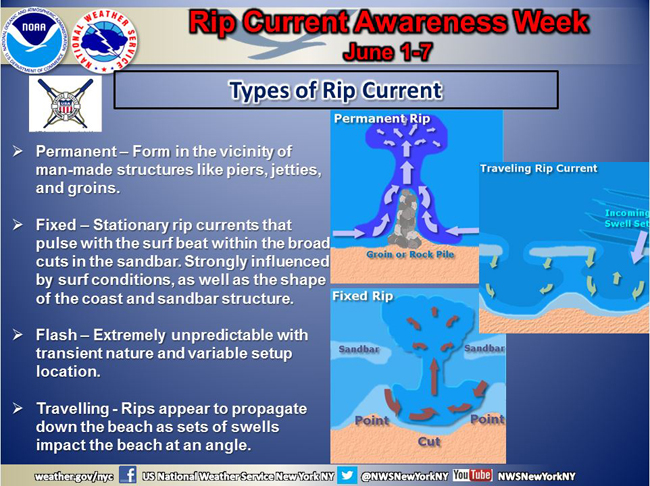
It's important to know the "types" of rip currents so that you know where is the safest place to swim. Photo: NOAA's U.S. National Weather Service - New York NY
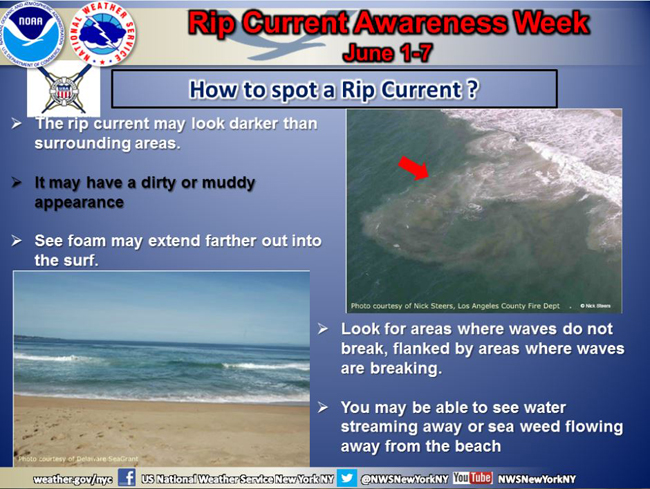
As always, swim in life guarded areas! Photo: NOAA's U.S. National Weather Service - New York NY
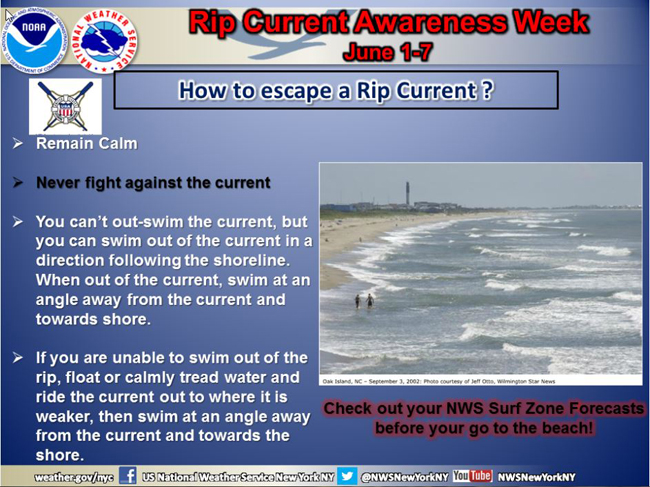
How to escape a Rip Current? First, remain calm and don't fight against it. Photo: NOAA's U.S. National Weather Service - New York NY
More Info: NOAA
NOAA's mission is to understand and predict changes in the Earth's
environment, from the depths of the ocean to the surface of the sun, and
to conserve and manage our coastal and marine resources. Join NOAA on Twitter, Facebook and our other social media channels and visit the organization's news release archive.
More Info: New York Sea Grant
New York Sea Grant (NYSG), a cooperative program of Cornell University
and the State University of New York, is one of 33 university-based
programs under the National Sea Grant College Program (NSGCP) of the
National Oceanic and Atmospheric Administration (NOAA). The NSGCP
engages this network of the nation’s top universities in conducting
scientific research, education, training and extension projects designed
to foster science-based decisions about the use and conservation of our
aquatic resources. Through its statewide network of integrated
services, NYSG has been promoting coastal vitality, environmental
sustainability, and citizen awareness about the State’s marine and Great
Lakes resources since 1971.
For updates on Sea Grant activities: www.nyseagrant.org has RSS, Facebook, Twitter, and YouTube links. NYSG also offers a free e-list sign up via www.nyseagrant.org/coastlines for NY Coastlines, its flagship publication, which, in 2014, merges with the program's e-newsletter, Currents. NY Coastlines is published several times a year.